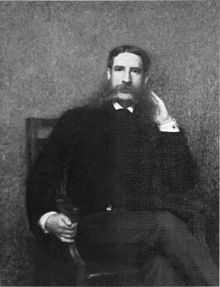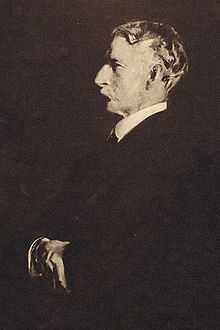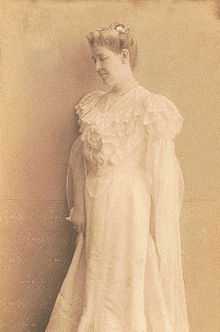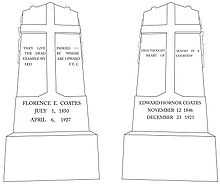Edward Hornor Coates
| Edward Hornor Coates | |
|---|---|
 | |
| Born |
November 12, 1846 Philadelphia, Pennsylvania, United States |
| Died |
December 23, 1921 (aged 71) Philadelphia, Pennsylvania, United States |
| Occupation |
Banker Patron of the Arts and Sciences |
Edward Hornor Coates (November 12, 1846 – December 23, 1921) was a Philadelphia businessman, financier, and patron of the arts and sciences. He served as Director of the Mechanics National Bank in 1873, was chairman of the Committee on Instruction at the Pennsylvania Academy of the Fine Arts from 1883 to 1890, and subsequently held the position of Academy president from 1890 to 1906. It was during his position as chairman that Mr. Coates commissioned The Swimming Hole from Thomas Eakins, only later to reject it.[1] Painter John McLure Hamilton, in a piece about Mr. Coates from Hamilton's book Men I Have Painted (1921),[2] describes Mr. Coates' time at the Academy:
The reign of Mr. Coates at the Academy marked the period of its greatest prosperity. Rich endowments were made to the schools, a gallery of national portraiture was formed, and some of the best examples of Gilbert Stuart's work acquired. The annual exhibitions attained a brilliancy and éclat hitherto unknown... Mr. Coates wisely established the schools upon a conservative basis, building almost unconsciously the dykes high against the oncoming flow of insane novelties in art patterns... In this last struggle against modernism the President was ably supported by Eakins, Anschutz, Grafly, Thouron,[3] Vonnoh, and Chase... His unfailing courtesy, his disinterested thoughtfulness, his tactfulness, and his modesty endeared him to scholars and masters alike. No sacrifice of time or of means was too great, if he thought he could accomplish the end he always had in view—the honour and the glory of the Academy.
In 1890, Mr. Coates was among the signatories of the "Independent Republicans of Pennsylvania" who urged for the election of the Democratic nominee Robert E. Pattison for Governor over the Republican nominee, George W. Delamater. A vote for Delamater, they stressed, would mean "the public indorsement" of the corrupt Matthew Stanley Quay, then junior Senator of the State of Pennsylvania.[4] Pattison would go on to win the Governorship. In 1894, Mr. Coates joined the ranks of the "Quaker City Rebels" in the continued fight against Mr. Quay and corrupt "bossism" politics.[5]
Mr. Coates was the son of Joseph Potts Hornor Coates and Eliza Henri Troth. He married first Ella May Potts in 1872. Ella May died on 9 May 1874 at the age of 22. Mr. Coates later wed Florence Earle Coates in 1879, daughter of prominent Philadelphia lawyer, George H. Earle, Sr. This was also a second marriage for Florence, whose first husband—William Nicholson—died in 1877 after only five years of marriage. Mr. Coates would eventually adopt Florence's daughter from her first marriage—Alice Earle Nicholson. Florence and Edward had one child together in 1881, but the baby—Josephine Wisner Coates—died in infancy.

The Coates' resided first in a home in Germantown, Pennsylvania—"Willing Terrace"—where they lived and entertained until about 1908. One of their guests was literary and social critic Matthew Arnold, whom they would host during his stays in Philadelphia. Mrs. Coates was both inspired and encouraged by Mr. Arnold to pursue her interest in writing poetry. This interest would eventually lead to the subsequent publishing of nearly three-hundred[6] poems in the leading magazines of her day, as well as five volumes of collected verse. The Coates' later removed to a Victorian townhome on Spruce Street in Philadelphia where they resided for the remainder of their lives together. The Coates' often spent their summer months in the Adirondacks, where they maintained "Camp Elsinore"—their summer camp by the Upper St. Regis Lake. It was there that they entertained, rested and escaped the humidity of Philadelphia summers. Many of Mrs. Coates' nature poems were inspired by the flora and fauna of the Adirondacks.

Edward Coates died on 23 December 1921. His funeral service was held at the Coates' Spruce Street home three days later, and he was buried at the Church of the Redeemer (Episcopal) churchyard in Bryn Mawr, Pennsylvania. The inscription on Mr. Coates' headstone reads, "High thought seated in a heart of courtesy"—Sir Phillip Sydney's description of an honorable man and gentleman.[7]
In 1923, Mrs. Coates presented The Edward H. Coates Memorial Collection to the Pennsylvania Academy of the Fine Arts in Philadelphia. The collection included paintings by Robert Vonnoh (to include the portrait of Mr. Coates shown above), a portrait of Mrs. Coates painted by Violet Oakley in 1912 entitled The Tragic Muse, and a portrait bust of Mr. Coates sculpted by Charles Grafly. Twenty-five other paintings from various artists, as well as two other pieces of sculpture, were also included in the collection. The collection was placed on exhibit at the Academy from 4 November 1923 to 10 January 1924.[8][9]

References
- ↑ Directors and Members of the Mechanics National Bank
- ↑ Hamilton, John McLure. Men I Have Painted. London: T. Fisher Unwin Ltd., 1921; p. 176-180
- ↑ Henry Joseph Thouron (1851-1915)
- ↑ "Against Quay and Delamater" (New York Times, 8 September 1890)
- ↑ "The Quaker City Rebels" (New York Times, 30 December 1894)
- ↑ Bohm, Sonja N., comp. The Published Works of Florence Earle Coates (Magazines). 2009. Print.
- ↑ Information based on research conducted by Sonja N. Bohm, who has documented her burial research on Flickr
- ↑ PAFA website: Exhibitions 1805-1999
- ↑ Coates, Florence Earle. The Edward H. Coates Memorial Collection (1923)